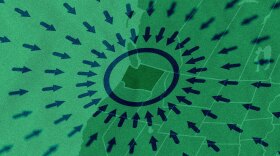It is rather rough to see that we are still in the stage of our swaddling clothes, and it is not surprising that the fellows struggle against admitting it (even to themselves).
This is how Einstein closed his letter of December 22, 1950, to physicist Erwin Schrödinger — one of the architects of quantum mechanics. The "fellows" were Bohr, Heisenberg, Dirac and the majority of other physicists who embraced the so-called Copenhagen Interpretation of quantum mechanics which, among other things, restricted how much we could know of reality: there is an insurmountable barrier, summarized in Heisenberg's Uncertainty Principle, that states that we can't know both the position and the velocity of a quantum object (an electron, a proton, an atom) with arbitrary precision. This is not a technological limitation, but a matter of principle; it's how Nature is.
There is more. A quantum object can be in two places at once; it can go across obstacles, like a ghost; it can be dead and alive at the same time, like Schrödinger's unfortunate cat.
Are these things for real? Is this the world you live in?
Einstein and Schrödinger would have none of that. They would accept that reality is stranger than fiction, that the quantum world is different from our everyday reality. But they would hold that this is a temporary setback; we just have to find the right theory and we are back at being able to determine things as comfortably as we can with the motion of a falling rock.
Although the back and forth between the two groups is a fascinating chapter in the history of science, the answer is in the experiments. And it is here that the amazing reality of the quantum shows up without any signs of abating.
Behind the mystery is the infamous (or some may say beautiful) wave-particle duality, that things, especially little things, can and should be viewed as being both a particle — thus limited in space — and a wave — thus spread out in space. Unless you are a Taoist, to be two opposite things at once is very weird, like being hot and cold, light and dark or tall and short.
Heisenberg and Bohr claimed that it's not the quantum world fault, it's ours; electrons are neither particles nor waves; these are images we construct from our everyday experience, and such intuitions are inappropriate to describe what really goes on down there. The math, though, is crystal clear. We can compute at will, finding out the various properties of electrons, atoms and molecules with remarkable accuracy. A probabilistic theory doesn't imply in a flaky theory.
This all started in 1924, when Louis de Broglie conjectured that electrons and all bits of matter display both particle and wave properties. Einstein loved the idea, initially. In 1927, Clinton Davisson and Lester Germer observed electrons diffracting off a nickel crystal, something that only waves can do: de Broglie was right, electrons can behave as waves. Passing through two small slits, they interfere with one another, creating a light and dark interference pattern on a screen. Bullets wouldn't do that; they'd pile up on the screen right behind the holes.
In 1989, Akira Tonomura from Hitachi in Japan managed to make single electrons interfere, bringing the notion that matter particles behave like waves to unprecedented clarity. A single electron passes through two slits at the same time in order to create an interference pattern; this is why people say that in the quantum world things can be in two places at once.
What about bigger objects? Is there a limiting size beyond which this peculiar quantum behavior is lost? Can we interfere as waves? Due to amazing technological advances, diffraction experiments have been performed with neutrons (two thousand times heavier than electrons), atoms and even molecules hundreds of times larger than electrons. An amazing example is the 1999 experiment by Anton Zeilinger and his group at the University of Vienna, where interference was achieved for buckyballs, the large (60 carbon atoms) soccer-ball-shaped molecules that look like Buckminster Fuller's geodesic domes.
The bigger the object the harder it is to demonstrate self-interference. Imagine a soccer ball scoring two goals at once!
The next step is to attempt interference experiments with viruses; and then with actual living things. How does life respond to quantum interference? Can something interfere with itself and remain alive? It's a long shot from "beam me up, Scotty"; but we will only manage to do that in 2260 if scientists keep pushing the boundaries now.
You can keep up with more of what Marcelo is thinking on Facebook and Twitter: @mgleiser
Copyright 2021 NPR. To see more, visit https://www.npr.org.







